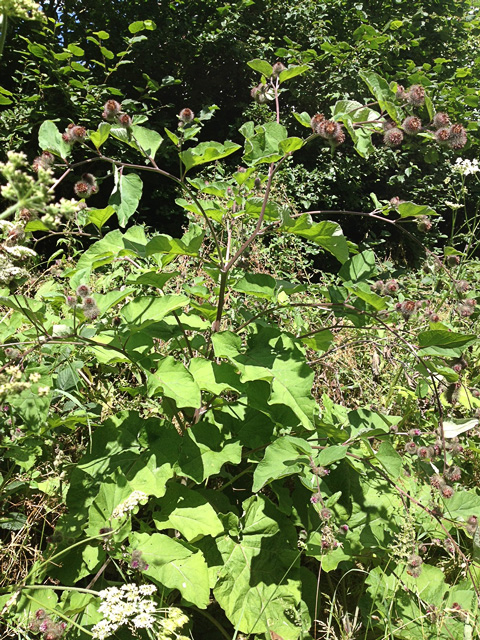
As medical herbalists, we think of Burdock mainly as a deep cellular detoxifying herb. I have also discovered that the leaf is a natural anti-biotic, and with this information in mind, Burdock is one of our first ‘go-to’ herbs when treating conditions such as acne vulgaris, boils, abscesses etc. However, as I researched Burdock for this article, I discovered that there is so much more to this handsome giant of the hedgerows.
Several studies point to the roots and seeds having remarkable anti-diabetic actions. With diabetes our blood sugars rise because the insulin levels decline, and unhealthy levels of cholesterol rise. Burdock increases insulin, and leptin (that hormone which tells us that we have had enough to eat), and decreases the dangerous blood fats.(1),(2)
Another study confirmed this when they recorded how Burdock root and nettle leaves reduced the blood sugars and cholesterol levels in mice.(3)
Burdock has anti-cancer properties. The leaf was compared with a chemotherapy drug called doxorubicin which is used for breast and bladder cancers. The researchers found Burdock and doxorubicin to be similar in their ability to reduce the tumour cells,(4) and another study noted that the seeds are known to potently inhibit pancreatic cancers(5) – which makes sense considering its effect on the insulin producing cells of the pancreas.
Researching Burdock’s anti-biotic actions, I discovered two studies which show it to be effective against serious lung diseases. One study showed Burdock to be antibiotic against the tuberculosis bacteria, Mycobacterium tuberculosis,(6) and another showed Burdock to be significantly effective against persistent infections caused by Klebsiella pneumonia, one of the bacteria responsible for pneumonia and bronchitis.(7)
The anti-microbial actions are not limited to the lungs. Burdock showed great potential against bacteria and fungi found in the mouth. When people have a weakened immune system, such as those taking chemotherapy, the elderly, or alcoholic folk, they are more susceptible than most to infections such as those mentioned above. Burdock was found to be even better at stimulating antibodies to infections than Echinacea.(8),(9)
On a lighter note – I was thrilled to discover that Burdock seeds powerfully stimulate collagen formation and hyaluronan levels (that is the stuff they inject into wrinkles as a natural filler) and the results of this particular study showed that it significantly reduced wrinkles and crow’s feet.(10)
(1)^ Ahangarpour A, Heidari H, Oroojan AA, Mirzavandi F, Nasr Esfehani K, Dehghan Mohammadi Z. Antidiabetic, hypolipidemic and hepatoprotective effects of Arctium lappa root’s hydro-alcoholic extract on nicotinamide-streptozotocin induced type 2 model of diabetes in male mice. Avicenna Journal of Phytomedicine. 2017;7(2):169-179. PMCID: PMC5355822
(2)^ Xu Z, Gu C, Wang K, Ju J, Wang H, Ruan K, Feng Y. Arctigenic acid, the key substance responsible for the hypoglycemic activity of Fructus Arctii. Phytomedicine. 2015 Jan 15;22(1):128-37. doi:10.1016/j.phymed.2014.11.006
(3)^ Vengerovskii AI, Yakimova TV, Nasanova ON. Influence of Medicinal Plant Extracts on the Functions and Antioxidant Protection of Erythrocytes in Rats with Experimental Diabetes Mellitus. Eksp Klin Farmakol. 2016;79(2):29-33. PMID: 27416680
(4)^ Ghafari F1, Rajabi MR, Mazoochi T, Taghizadeh M, Nikzad H, Atlasi MA, Taherian A. Comparing Apoptosis and Necrosis Effects of Arctium Lappa Root Extract and Doxorubicin on MCF7 and MDA-MB-231 Cell Lines. Asian Pac J Cancer Prev. 2017 Mar 1;18(3):795-802. doi: 10.22034/APJCP.2017.18.3.795 (PDF)
(5)^ Yuk-Shing Chan, Long-Ni Cheng, Jian-Hong Wu, Enoch Chan, Yiu-Wa Kwan, Simon Ming-Yuen Lee, George Pak-Heng Leung, Peter Hoi-Fu Yu, Shun-Wan Chan. A review of the pharmacological effects of Arctium lappa (burdock). Inflammopharmacology. 2011 Oct;19(5):245-54. doi: 10.1007/s10787-010-0062-4
(6)^ Zhao J, Evangelopoulos D, Bhakta S, Gray AI, Seidel V. Antitubercular activity of Arctium lappa and Tussilago farfara extracts and constituents. J Ethnopharmacol. 2014 Aug 8;155(1):796-800. doi: 10.1016/j.jep.2014.06.034
(7)^ Rajasekharan SK, Ramesh S, Satish AS, Lee J. Antibiofilm and Anti-β-Lactamase Activities of Burdock Root Extract and Chlorogenic Acid against Klebsiella pneumoniae. J Microbiol Biotechnol. 2017 Mar 28;27(3):542-551. doi: 10.4014/jmb.1609.09043. (PDF [slow download])
(8)^ Borsuk OS, Masnaya NV, Sherstoboev EY, Isaykina NV, Kalinkina GI, Reihart DV. Effects of drugs of plant origin on the development of the immune response. Bull Exp Biol Med. 2011 Jun;151(2):194-6. PMID: 22238748
(9)^ Pereira JV, Bergamo DC, Pereira JO, França Sde C, Pietro RC, Silva-Sousa YT. Antimicrobial activity of Arctium lappa constituents against microorganisms commonly found in endodontic infections. Braz Dent J. 2005;16(3):192-6. doi: 10.1590/S0103-64402005000300004
(10)^ Knott A, Reuschlein K, Mielke H, Wensorra U, Mummert C, Koop U, Kausch M, Kolbe L, Peters N, Stäb F, Wenck H, Gallinat S. Natural Arctium lappa fruit extract improves the clinical signs of aging skin. J Cosmet Dermatol. 2008 Dec;7(4):281-9. doi: 10.1111/j.1473-2165.2008.00407.x
